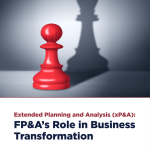xP&A is more than an attempt to ‘fix’ the planning process. It is a complete transformation...

The ongoing turmoil and uncertainty in the world today have accelerated a long-coming transition. It has awakened organisations’ need for strategic workforce planning solutions to manage a regular business and sudden changes to pivot, adapt, and thrive.
Fortunately, Extended Planning and Analysis (xP&A) is positioned to meet these challenges head-on. xP&A is an integrated and real-time planning approach that extends FP&A deeper into businesses by linking strategic, financial, and operational plans from all essential functions.
xP&A is not just:
- Anticipating the future
- An inventory of all positions
- Creating plans as a one-time event
- Creating reports to analyse “what was”
xP&A:
- Emphasises longer-term contexts for short-term decision-making
- Focuses on granular role details proactively
- Creates plans to respond to strategic and market shifts
- Focuses on what “will be”
What Is Workforce Planning?
The idea of workforce planning is simple. Suppose the right people with the right competencies are at the right places at the right time. In that case, an organisation can achieve its strategic and operational goals — leveraging human capital to ensure a workforce is in place to meet today’s needs.
Workforce planning highlights the “people factor” in achieving results. It does this by providing managers throughout an organisation with a framework for making staffing decisions. These decisions are based on an organisation’s mission, strategic plan, budgetary resources, and desired workforce competencies and are made by identifying and addressing gaps in ongoing needs.
Questions to be Answered
While Human Resource (HR) leaders are adept at planning talent at the headcount and cost-per-hire levels within business units (BUs), they struggle to integrate deeper to ensure alignment between strategy, operations, and day-to-day tactics.
These questions include:
- How long does it take to train a new hire to be operationally effective?
- What percentage will need to be replaced and anticipated?
- Which factors influence turnover?
- What is the number of FTEs and skills and competencies of positions?
- Developmental and certification needs?
- Training and development opportunities to develop critical skills?
- Budget for overall employee development? What results have investments produced?
- What are the significant risks in preparing to meet future workforce needs?
- Confidence in meeting workforce requirements in the coming year and the next three to five years?
xP&A Enhanced Workforce Planning Leads to Answers
Workforce planning powered by xP&A is the missing piece that helps an organisation plan talent with more detailed levels. This allows it to answer outstanding questions and delineate hiring and staffing priorities.
xP&A allows HR leaders to create transparency into skills needed within and across BUs to inform workforce plan creation and facilitate the dynamic transfer of skills within the internal labour market. Meanwhile, it prioritises requests based on urgency and criticality to meeting strategic priorities.
In addition, with enhanced visibility, rapid-fire timeliness, and a linkage between needs and costs, HR leaders can begin planning better using xP&A to determine how staffing needs affect:
- Organisational design and structure
- Number and kinds of skills needed at each level of expertise
- Number and types of teams
- Volume, type, and location of work
- Supervisor-employee ratios
That’s not all — workforce planning powered by xP&A also enables HR leaders to:
- Maximise organisational effectiveness by integrating the organisation’s mission, strategic plan, budget, technology, and human resources.
- Synchronise the workforce plan with other business plans — corporate strategy, financials, operations, departmental budgets, and forecasts.
- Prepare for contingencies that could prevent the organisation from attaining its goals.
- Align organisational direction and articulation of measurable goals and objectives.
- Allocate resources to sustain operations and achieve goals.
Now, when the organisation must shift to meet new demand and supply constraints, it can do so confidently. Questions finally have forward-looking, detailed responses to answer the most critical business needs.
For instance, if a factory in Ohio starts production on a new line in 9 months, xP&A can assist HR in providing feedback to determine how many labourers and supervisors are required for each level of production, at which rates, applicable training-to-production lead times, and which retention programs will ensure the workforce is reliable and consistent.
Taking Action with xP&A in Workforce Planning
By utilising xP&A in the workforce planning and review process, the needs and inputs of all functions are finally consolidated, assessed, and shared with a high level of confidence among decision-makers.
xP&A is the workforce planning tool we’ve waited for to drive integration and collaboration between various stakeholders, processes, and data streams. It is critical to moving an organisation forward by knowing which type of labour is needed, where and when.
By embracing xP&A, HR leaders will continue to play a critical role in developing an enterprise for the future, leading to thoughtful, well-timed, and resource-efficient growth.
This article was first published on the SAP blog.
Subscribe to
FP&A Trends Digest

We will regularly update you on the latest trends and developments in FP&A. Take the opportunity to have articles written by finance thought leaders delivered directly to your inbox; watch compelling webinars; connect with like-minded professionals; and become a part of our global community.






